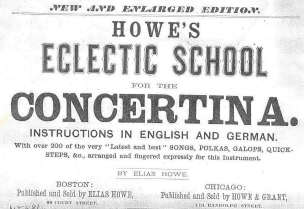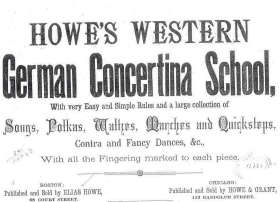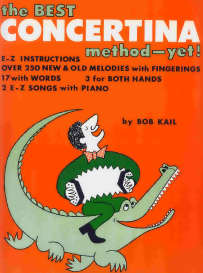Back to the Future: De Ville’s The Concertina and
|
|
|
|
|
Posted 15 February 2003 Back to the Future: De Ville’s The Concertina and
|
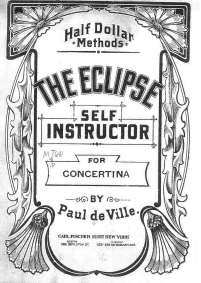
Fig. 1a. Cover of Paul de Ville, The Eclipse Self Instructor For Concertina, 1905. (Click to enlarge.) |
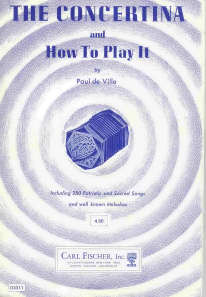
Fig. 1b. Cover of Paul de Ville, The Concertina and How to Play It, 1905. (Click to enlarge.) |
A somewhat surprising discovery is that 208 of the 250 tunes in The Concertina and How to Play It were taken directly from two books by Elias Howe, Jr.3 (see Figs. 2 and 3)—i.e., 98 tunes from Howe’s Eclectic School for the Concertina (Boston: Elias Howe; and Chicago: Howe & Grant, 1879), 108 tunes from Howe’s Western German Concertina School (Boston: Elias Howe; and Chicago: Howe & Grant, 1879),4 and two tunes that appeared in both of these Howe books. With a few minor exceptions, the musical arrangements and tablature in The Concertina and How to Play It are identical to those in Howe’s books.5 Howe’s books contain a number of songs with lyrics. The Concertina and How to Play It includes some of these songs but without the lyrics.
The Concertina and How to Play It contains 42 tunes that do not appear in Howe’s concertina books. A few of these tunes are still well known—e.g., “Rickett’s Hornpipe,” “My Old Kentucky Home,” “Adestes Fideles,” “Rock of Ages,” “Nearer My God to Thee,” and “Sweet Bye and Bye.” The original sources for these 42 tunes have not been documented. Six of theses tunes (i.e., “College Hornpipe,” “The Coquette,” “Morella’s Lesson,” “Old Zip Coon,” “Rory O’More,” and “The Tempest”) are the same arrangements as those found in Howe’s The Complete Preceptor for the Accordeon (Boston: Oliver Ditson, 1843, 1850, and 1851), suggesting that de Ville appropriated these arrangements and wrote concertina tablature to replace Howe’s accordion tablature.
Almost all instructions, scales, and exercises in The Concertina and How to Play It were taken verbatim or in paraphrase from Howe’s books. However, the “Rudiments of Music” section of de Ville’s book was borrowed elsewhere.6 This section is larger and more advanced than the “Elementary Rules of Music” in Howe’s Eclectic School for Concertina. The advanced material in the section has no direct relevance to the other sections of The Concertina and How to Play It.
The Concertina and How to Play It contains an illustration (taken from Howe’s books) of the notes for the 28-key German concertina, even though all tunes in de Ville and Howe’s books are tablatured exclusively for the 20-key concertina. The 28-key German concertina had slipped into obscurity long before de Ville’s book was published.7
The Successor to De Ville’s Book
Bob Kail’s The Best Concertina Method—Yet! (1975) contains 249 of the 250 tunes from The Concertina and How to Play It.8 Except for eradicating the tune numbering and enlarging the pages, Kail reproduced the tunes exactly as shown in de Ville’s book.9 Kail’s book contains (1) Elementary Music Principles (1 page), (2) a description of how to hold the concertina and how to read tablature (1/2 page), (3) scales and exercises from de Ville’s book, (4) twenty-nine songs arranged by Kail,10 and (5) the 249 tunes from de Ville’s book. Kail structured his book to downplay the acquisition of tunes from de Ville, but made no outright attempt to conceal the fact. The first part of Kail’s book contains scales, exercises, and a few tunes from de Ville, interspersed with songs arranged by Kail. The second part contains 235 tunes that are reproduced in the same order--even with the same page numbers--as in The Concertina and How to Play It. The last part contains more songs arranged by Kail and more exercises from de Ville’s book, as well as a couple exercises by Kail. The note layout for the 28-key German concertina was not included in Kail’s book, and the 20-key concertina diagram in de Ville’s book (p. 15) was transformed into a pull-out card to accompany Kail’s book.
Paul de Ville’s book contains no table of contents or tune index, and Kail’s book contains no tune index. Kail’s book has a table of contents, but the tunes taken from de Ville’s book are not individually listed therein. A complete index of all instructional material and tunes in The Concertina and How to Play It and The Best Concertina Method—Yet! is shown in the annex.
The Kail and de Ville books have similar retail prices, even though The Best Concertina Method—Yet! contains almost all of the contents of The Concertina and How to Play It, as well as the songs and exercises not found in de Ville’s book. A minor selling point for the de Ville book has been its smaller size (6¾-by-10 inches, compared with 8½-by-11 inches for Kail’s book), making it convenient for storage in non-fitted concertina cases. The latest printing has a slightly larger format of 6¾-by-10½ inches.
Notes
1 All printings show “Copyright 1905 by Carl Fisher, New York, Printed in U.S.A.” The approximate date of printing can be ascertained from the suggested retail price that is printed on the outside cover. For example, a printing from the 1950s shows “1.35” (i.e., $1.35), and later printings through the mid-1990s show successively higher prices—“2.00,” “2.50,” “3.00,” etc. [ Back to text ]
2 Paul de Ville, The Eclipse Self Instructor for Concertina (New York: Carl Fischer, Inc., 1905) was one of the “Half Dollar Methods” that Fischer published for various instruments. Paul de Ville authored instruction books for many instruments--accordion, banjo, clarinet, flute, guitar, mandolin, piano, saxophone, trombone, violin, and others. His accordion and organ books were published in 1893, but the majority of his instruction books were published somewhat later—several in 1905 and 1906. The Eclipse Self Instructor for Concertina has a larger format and refers to the instrument as “the German or Anglo-Saxon concertina,” whereas The Concertina and How to Play It refers to simply “the concertina.” Otherwise, the contents of the books are identical. [ Back to text ]
3 Elias Howe Jr. (1820-1895) was a well-known collector of fiddle tunes, music publisher, and instrument maker, dealer, and collector. He published about 200 books, including tutors for many instruments and tune books of which the best known are The Musician’s Companion (Boston: Kidder and Wright, 1840) and William Bradbury Ryan, Ryan’s Mammoth Collection (Boston: Elias Howe, 1883). This Elias Howe Jr. is sometimes confused with another Elias Howe Jr. (1819-1867), the sewing machine inventor. Both Elias Howes were descendents of John Howe, who settled in Massachusetts in the 1600s. Unacknowledged use of Howe’s material was not limited to his concertina books. In the 1980s, it was discovered that One Thousand Fiddle Tunes (Chicago: M. M. Cole Company, 1940) was Ryan’s Mammoth Collection in disguise. For more about Elias Howe Jr. and his publications, see Patrick Sky, Ryan’s Mammoth Collection (Pacific, Missouri: Mel Bay Publications, 1995), pp. 7-21. [ Back to text ]
4 “New and Enlarged Edition” on the cover of Howe’s Eclectic School for Concertina refers to expansion of Howe’s New German Concertina (Boston: Oliver Ditson and Co., circa 1865) and Howe’s New Concertina Without a Master. (St. Louis: Balmer & Weber, circa 1870). Both of the Howe tutors discussed in the text are available in full on this website, Howe’s Eclectic School for the Concertina and Howe’s Western German Concertina School. [ Back to text ]
5 The ordering of tunes in de Ville’s book consists of a block of tunes from Howe’s Eclectic School for Concertina, followed by a block from Howe’s Western German Concertina School, followed by another block from Howe’s Eclectic School for Concertina, etc. The tunes not taken from Howe’s books are interspersed among these blocks. Paul de Ville made some relatively minor changes in a few tunes. He changed the pick-up notes of the “Star Spangled Banner” and inserted accidentals not found in a couple tunes in Howe’s books. De Ville passed up 149 other tunes in Howe’s books, including “Three Blind Mice,” “Santa Lucia,” and a few others that are still well known. “Aunt Jemima’s Plaster,” “Female Auctioneer,” “Dog and Gun,” and others are now relatively obscure. [ Back to text ]
6 It appears that the material came from a nineteenth-century tutor for English concertina. [ Back to text ]
7 Export of the 28-key German concertina from Saxony began in the early 1850s. From the late 1850s onward, British makers began developing chromatic Anglos that soon superceded the 28- key German concertina. Illustrations of the note layout of the 28-key German concertina appeared in new editions of Anglo concertina tutors from Britain and the U.S. after the 28-key German concertina had become nearly extinct. For early and later examples, see George Cameron, Cameron’s Selection of Concertina Music: Containing Complete Instructions and Scales . . . for the Ten, Twenty, Twenty-Two, and Twenty-Eight Keyed German Concertina (Glasgow: George Cameron, 1857); Joseph R. W. Harding, New and Complete Method for the German Concertina, With Scales for 10, 20, 22, and 28 Keys (London: Metzler & Co., 1858); Alfred B. Sedgwick, Sedgwick’s Improved and Complete Instructor for the German Concertina (Boston: Oliver Ditson and Co., 1865 and 1893); and Septimus Winner, Winner’s Perfect Guide for the German Concertina (Boston: Oliver Ditson Company, 1869 and 1893). De Ville’s book was the last that showed the layout for the 28-key German concertina. [ Back to text ]
8 “When the Swallows Homeward Fly” was omitted. [ Back to text ]
9 Three tunes with racist titles—“Ten Little N-----s” [blanks inserted], “Jim Crow Polka”, and “Old Zip Coon”—were taken from Howe’s books. “Ten Little N-----s” was retitled as “Ten Little Soldiers” in de Ville’s book and as “Ten Little Dancers” in Kail’s book. The most recent printings of both books still contain “Jim Crow Polka” and “Old Zip Coon” (now better known as “Turkey in the Straw”). [ Back to text ]
10 These are American standards (“Blue Tail Fly,” “Careless Love,” “O Susanna,” “Darling Clementine,” “Battle Hymn of the Republic,” “Silent Night,” etc.) and a couple international standards (“Cielito Lindo” and “O Sole Mio”). Some have only single-note melody lines; others have separate melody and accompaniment parts. Lyrics are included for all songs except the “The Entertainer.” [ Back to text ]
Annex
Index to Paul de Ville, The Concertina and How to Play It (New York: Carl Fisher, 1905) and Bob Kail, The Best Concertina Method—Yet! (Carlstadt, NJ: Ashley Publications, 1975).
Tune |
De Ville |
Kail |
| When the Swallows Homeward Fly | 20 | — |
| A Bicycle Built for Two | — | 83 |
| Battle Hymn of the Republic | — | 15 |
| Careless Love | — | 13 |
| Cielito Lindo | — | 7 |
| Down by the Riverside | — | 93 |
| Frankie and Johnny | — | 96 |
| I Love You Truly | — | 21 |
| In the Good Old Summertime | — | 85 |
| I’ve Been Working on the Railroad | — | 86 |
| Little Brown Jug | — | 19 |
| My Darling Clementine | — | 81 |
| Wild Irish Rose | — | 18 |
| On Top of Old Smoky | — | 84 |
| O Sole Mio | — | 90 |
| O Susanna | — | 10 |
| Scarborough Fair | — | 20 |
| She’ll Be Coming ‘Round the Mountain | — | 80 |
| Shenandoah | — | 11 |
| Silent Night | — | 22 |
| Sweet Rosie O’Grady | — | 92 |
| The Blue Tail Fly | — | 14 |
| The Camptown Races | — | 84 |
| The Cruel War Is Raging | — | 91 |
| The Entertainer | — | 82 |
| The Man on the Flying Trapeze | — | 81 |
| The Marines’ Hymn | — | 8 |
| There Is a Tavern in the Town | — | 89 |
| The Wabash Cannonball | — | 12 |
| When the Saints Go Marching In | — | 9 |
| Adeste Fideles | 79 | 79 |
| Air from Lucia di Lammermoor | 60 | 60 |
| A Life on the Ocean Wave | 41 | 41 |
| Alps | 72 | 72 |
| America | 23 | 23 |
| Am I Not Fondly Thine Own | 38 | 38 |
| Annie Laurie | 43 | 43 |
| Anvern | 69 | 69 |
| Arkansas Traveler | 53 | 53 |
| As I’d Nothing Else To Do | 28 | 28 |
| Augusta’s Favorite | 20 | 16 |
| Auld Lang Syne | 45 | 45 |
| Bachelor’s Hall | 31 | 31 |
| Balerma | 67 | 67 |
| Beautiful Belle | 39 | 39 |
| Beautiful Nell | 29 | 29 |
| Be Gone, Dull Care | 34 | 34 |
| Be Joyful in God, All Ye Lands of the Earth | 75 | 75 |
| Belle Brandon | 37 | 37 |
| Benevento | 72 | 72 |
| Blue Bells of Scotland | 36 | 36 |
| Bonnie Blue Flag | 24 | 24 |
| Bonnie Dundee | 25 | 25 |
| Bonny Doon | 34 | 34 |
| Boston Hop Waltz | 63 | 63 |
| Bower of Prayer | 72 | 72 |
| Brian Boru | 27 | 27 |
| Bryan O’Lynn | 22 | 17 |
| Cambridge | 69 | 69 |
| Camptown Hornpipe | 25 | 25 |
| Canaan | 76 | 76 |
| Castles in the Air | 33 | 33 |
| Cephas | 71 | 71 |
| Charley Over the Water | 22 | 16 |
| Charming Young Widow, or Mantle So Green | 28 | 28 |
| Chinese Dance, or Hark the Merry Bells, from Stradella | 51 | 51 |
| Chinese March | 56 | 56 |
| Chorus Jig | 49 | 49 |
| Cinderella Waltz | 63 | 63 |
| Clarance | 70 | 70 |
| Clifford | 75 | 75 |
| Clog Dance No. 2 | 52 | 52 |
| Colchester | 69 | 69 |
| College Hornpipe, or Sailor’s Hornpipe | 51 | 51 |
| Columbian Grand March | 57 | 57 |
| Come, Come, Soldiers, Come | 45 | 45 |
| Come, Good Shepherd | 68 | 68 |
| Come Ye Disconsolate | 73 | 73 |
| Comin’ Thro’ the Rye | 20 | 17 |
| Conway | 70 | 70 |
| Coronation March (“Prophet”) | 56 | 56 |
| Cracovienne | 21 | 6 |
| Dallas | 72 | 72 |
| Dearest Spot on Earth To Me Is Home | 46 | 46 |
| Dedham | 72 | 72 |
| Diamond Schottische | 64 | 64 |
| Dixie | 24 | 24 |
| Do They Think of Me at Home? | 38 | 38 |
| Dover | 68 | 68 |
| Dream of the Ocean Waltz | 62 | 62 |
| Drunken Sailor, or The Monkey’s Wedding | 52 | 52 |
| Duane Street | 77 | 77 |
| Duke Street | 74 | 74 |
| Effingham | 69 | 69 |
| Elfin Waltz | 64 | 64 |
| Ever of Thee | 36 | 36 |
| Fairy Waltz | 62 | 62 |
| Favorite Song (“Lucia di Lammermoor”) | 45 | 45 |
| Federal Street | 74 | 74 |
| Flora’s Birthday | 26 | 26 |
| Flying Cloud Schottische | 65 | 65 |
| Fred Wilson’s Clog Dance No. 1 | 52 | 52 |
| Gabriella Polka | 59 | 59 |
| Gallopade Quadrille | 59 | 59 |
| Garibaldi March | 57 | 57 |
| Gay and Happy | 59 | 59 |
| Glory Hallelujah | 34 | 34 |
| Golden Hill | 68 | 68 |
| Grand March in Norma | 54 | 54 |
| Greenville | 76 | 76 |
| Hail, Columbia | 24 | 24 |
| Hail to the Chief | 51 | 51 |
| Hamburg | 69 | 69 |
| Haste to the Wedding | 53 | 53 |
| Hebron | 67 | 67 |
| Helter Skelter, or Over Sticks and Stones Galop | 58 | 58 |
| Her Bright Smile Haunts Me Still | 46 | 46 |
| Hervey | 71 | 71 |
| Hob or Knob, or the Campbells Are Coming | 54 | 54 |
| Home, Sweet Home | 21 | 16 |
| How Beauteous Are Their Feet | 75 | 75 |
| How Can I Leave Thee? | 47 | 47 |
| Hunting the Hare, or The Calais Packet | 51 | 51 |
| I’d Offer You This Hand of Mine | 43 | 43 |
| If I Had But a Thousand a Year | 28 | 28 |
| I Heard the Wee Bird Singing | 23 | 23 |
| Il Bacio Waltz (The Kiss Waltz) | 62 | 62 |
| I’m Leaving Thee in Sorrow, Annie | 35 | 35 |
| Immortellen Waltz | 60 | 60 |
| Indian Death Song | 21 | 6 |
| I Need Thee Every Hour | 79 | 79 |
| In Happy Moments (“Maritana”) | 33 | 33 |
| In the Lonely Grove (“Linda”) | 44 | 44 |
| Irish Washerwoman | 50 | 50 |
| Italian Hymn | 74 | 74 |
| It Is Better to Laugh Than Be Sighing | 44 | 44 |
| I’ve Nothing Else to Do | 48 | 48 |
| Jefferson and Liberty | 53 | 53 |
| Jerusalem the Golden | 38 | 38 |
| Jim Crow Polka | 58 | 58 |
| John Anderson, My Joe [Jo] | 30 | 30 |
| Johnny Sands | 27 | 27 |
| Jordon | 71 | 71 |
| Jordon Am a Hard Road | 50 | 50 |
| Kate Kearney | 49 | 49 |
| Kathleen Mavourneen | 48 | 48 |
| Keemo Kimo | 32 | 32 |
| Kildoughalt Fair | 40 | 40 |
| Kitty of Coleraine | 32 | 32 |
| Lament of the Irish Emigrant | 32 | 32 |
| Lancers Quadrilles (Nos. 1-5) | 65-66 | 65-66 |
| Land of Rest | 71 | 71 |
| Land of Sweet Erin | 49 | 49 |
| Lanesboro’ | 77 | 77 |
| Larry O’Gaff | 41 | 41 |
| Last Rose of Summer | 37 | 37 |
| Lisbon | 76 | 76 |
| Lischer | 73 | 73 |
| Listen to the Mocking Bird | 38 | 38 |
| Listen to the Nightingale | 20 | 17 |
| Little Maggie May | 29 | 29 |
| Lord Lovell | 22 | 6 |
| Louisville March | 55 | 55 |
| Lucia March (“Lucia di Lammermoor”) | 46 | 46 |
| Mabel Waltzes | 60 | 60 |
| Maiden’s Prayer | 37 | 37 |
| Maid of Judah, or Silver Moon | 42 | 42 |
| Marching Along | 35 | 35 |
| Marching Thro’ Georgia | 26 | 26 |
| Martyrdom | 70 | 70 |
| Maryland, My Maryland | 24 | 24 |
| Mary of Argyle | 35 | 35 |
| Massa’s in the Cold, Cold Ground | 26 | 26 |
| Matrimonial Sweets | 44 | 44 |
| Mendon | 71 | 71 |
| Millennium Dawn | 76 | 76 |
| Missionary Hymn | 77 | 77 |
| Moll Roon | 41 | 41 |
| Molly Bawn | 31 | 31 |
| Money Musk | 54 | 54 |
| Morella’s Lesson | 34 | 34 |
| Moulton | 68 | 68 |
| Mountain Maid’s Invitation | 44 | 44 |
| My Bible Leads to Glory | 78 | 78 |
| My Old Kentucky Home | 27 | 27 |
| Nashville | 77 | 77 |
| Nearer, My God to Thee | 78 | 78 |
| Nichols | 70 | 70 |
| Nobody Going to Marry Me? | 28 | 28 |
| No, Ne’er Can Thy Home Be Mine | 22 | 17 |
| Norah, The Pride of Kildare | 30 | 30 |
| O Haste, Crimson Morn (“Lucia di Lammermoor”) | 45 | 45 |
| Oh, Hear Me, Norma | 36 | 36 |
| Oh! How Happy Are They | 77 | 77 |
| Oh! I Should Like to Marry | 36 | 36 |
| O, Lassie, Art Thou Sleeping Yet? | 46 | 46 |
| Old Folks at Home | 26 | 26 |
| Old Hundred | 67 | 67 |
| Old Rosin the Beau | 23 | 23 |
| Old Zip Coon, or Turkey in the Straw | 50 | 50 |
| Oliphant | 74 | 74 |
| O, Nanny, Wilt Thou Gang With Me | 58 | 58 |
| On the Beautiful Blue Danube Waltz | 61 | 61 |
| On the Road to Boston | 53 | 53 |
| Ortonville | 70 | 70 |
| Over the Summer Sea (“Rigoletto”) | 42 | 42 |
| Pas Styrien | 42 | 42 |
| Peace, Troubled Soul | 78 | 78 |
| Peterborough | 67 | 67 |
| Pirates Chorus, or Ever Be Happy | 31 | 31 |
| Pop Goes the Weasel | 47 | 47 |
| Prescott | 74 | 74 |
| Prima Donna Waltz | 63 | 63 |
| Pulling Hard Against the Stream | 29 | 29 |
| Raw Recruits, or Abraham’s Daughter | 35 | 35 |
| Ricket’s [Rickett’s] Hornpipe | 25 | 25 |
| Robin Adair | 25 | 25 |
| Rochester Schottische | 64 | 64 |
| Rock of Ages | 78 | 78 |
| Rory O’More | 49 | 49 |
| Roses Waltz | 61 | 61 |
| Russian National Anthem | 67 | 67 |
| Sally, Come Up | 47 | 47 |
| Saw Ye, My Saviour | 72 | 72 |
| Scotch March | 55 | 55 |
| Shabby Genteel | 48 | 48 |
| Shining Shore | 39 | 39 |
| Shule Aroon | 41 | 41 |
| Sicilian Hymn | 68 | 68 |
| Soldier Laddie, or Independence Day | 42 | 42 |
| Spanish Dance | 52 | 52 |
| Spanish Waltz | 61 | 61 |
| Sparking Sunday Night | 22 | 6 |
| Star-Spangled Banner | 23 | 23 |
| St. Louis Quickstep | 57 | 57 |
| St. Martin’s | 70 | 70 |
| St. Patrick’s Day in the Morning | 39 | 39 |
| Strike the Cymbal | 21 | 6 |
| St. Thomas | 68 | 68 |
| Sweet Afton | 43 | 43 |
| Sweet Bye and Bye | 78 | 78 |
| Sweet Memories of Thee | 43 | 43 |
| Swiss Boy | 44 | 44 |
| Teddy, You Gander, or Bully for You | 40 | 40 |
| Tempest Quickstep | 54 | 54 |
| Ten Little Soldiers (De Ville)*; Ten Little Dancers (Kail)* * “Ten Little N-----s” [blanks inserted] in early printings | 28 | 28 |
| The Bell Goes A-ringing for Sai-rah | 29 | 29 |
| The Bright, Rosy Morning | 33 | 33 |
| The Coquette | 21 | 17 |
| The Flag of Our Union | 25 | 25 |
| The Girl I Left Behind Me | 37 | 37 |
| The Harp That Once Thro’ Tara’s Hall | 30 | 30 |
| The Heart That Feels No Sorrow | 39 | 39 |
| The Lord is Our Shepherd | 76 | 76 |
| The Low-Backed Car, or The Jolly Ploughman | 40 | 40 |
| The Merriest Girl That’s Out | 30 | 30 |
| The Morning Light Is Breaking | 73 | 73 |
| The Old Arm-Chair | 32 | 32 |
| The Peri Waltz | 60 | 60 |
| There Is a Fountain | 79 | 79 |
| The Stars and Stripes For Ever | 23 | 23 |
| The Tempest | 50 | 50 |
| The Witches’ Dance | 51 | 51 |
| Troas | 73 | 73 |
| Twilight Dews | 22 | 16 |
| Uxbridge | 73 | 73 |
| Virginia Quickstep | 59 | 59 |
| Washington March | 55 | 55 |
| We Wont Go Home Till Morning | 27 | 27 |
| What’s a’ the Steer, Kimmer | 33 | 33 |
| When Johnnie Comes Marching Home | 31 | 31 |
| Widow Machree | 40 | 40 |
| Wilmot | 68 | 68 |
| Windham | 67 | 67 |
| Within a Mile of Edinboro’ Town | 47 | 47 |
| Woodstock | 73 | 73 |
| Yankee Doodle | 23 | 23 |
| Zion | 67 | 67 |
| Zouave Quickstep | 56 | 56 |
Exercise (as numbered in De Ville) |
De Ville |
Kail |
| No. 1 Notes on the concertina (20 key) | 17 | — |
| No. 2 Scale of C Major | 17 | 4 |
| No. 3 Scale of G Major | 17 | 4 |
| No. 4 Right Hand, C Major | 18 | 5 |
| No. 5 Left Hand, C Major | 18 | 11 |
| No. 6 Right Hand, G Major | 18 | 5 |
| No. 7 Left Hand, G Major | 18 | 11 |
| No. 8 Right Hand, C Major | 18 | 5 |
| No. 9 Right Hand, C Major | 18 | 5 |
| No. 10 Right Hand, C Major | 19 | 5 |
| No. 11 Left and Right Hand, C Major | 19 | 17 |
| No. 12 Left and Right Hand Together, C Major | 19 | 88 |
| No. 13 Left and Right Hand Together, G Major | 19 | 88 |
| No. 14 Left and Right Hand Together, C Major | 19 | 88 |
| Left Hand Accompaniment and Multiple Notes | — | 87-88 |
Other |
De Ville |
Kail |
| Scale of the German Concertina With 28 Keys (Antiquated) | 16 | — |
| Diagram of 20-Key Concertina | 15 | Pull- out card |
Have feedback on this article? Send it to the author.
Reprinted from the Concertina Library
http://www.concertina.com
© Copyright 2000– by Randall C. Merris
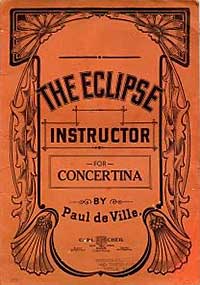
The Eclipse Self-Instructor
for Concertina, 1905
Contents
- Back to the Future: De Ville’s The Concertina and How to Play It and Other Tutors
- Introduction
- Predecessors of De Ville’s Book
- The Successor to De Ville’s Book
- Notes
- Annex: Index of Tunes and Exercises
© 2005 Randall C. Merris.
- Other articles
by Randall C. Merris
Links to related documents
-
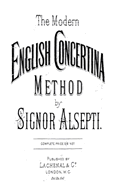 Instruction Manuals for the English, Anglo, and Duet Concertina: An Annotated Bibliography
Instruction Manuals for the English, Anglo, and Duet Concertina: An Annotated Bibliography
- by Randall C. Merris
- A comprehensive bibliography with more than 200 citations for concertina tutors that were published from the 1840s to the present. Separate sections deal with English, Anglo, and Duet tutors. The annotations contain considerable historical material on concertina makers, authors and teachers, performers, and publishers in the UK, US, and elsewhere. The web version incorporates citations for tutors that have appeared or were located subsequent to the original publication (about 35 more by 2005) and adds over 100 scanned photographs of tutor covers. A number of the tutors are available scanned in full on this website, and these are indicated in the entries. The original publication was in The Free-Reed Journal 4 (2002): 85-118, and a PDF version of the printed article is also available online.
- Posted 01 April 2003; last updated 31 August 2005
- » read full article
- » read Part 1, "English Concertina"
- » read part 2, "Anglo Concertina"
- » read part 3, "Duet Concertina"
- » read original article (without updates) in pdf"
-
 Howe’s Eclectic School for the Concertina (1879)
Howe’s Eclectic School for the Concertina (1879)
- by Elias Howe, Jr.
- Elias Howe (1820–1895) was a prolific nineteenth century publisher of sheet music and tutors for a wide variety of popular instruments of his day. This book, which is significantly lengthier than his “Western German Concertina School” tutor, has a slightly more detailed introduction to playing the German concertina. This introduction is written in both English and German, indicating that at least some German-Americans were using the two row Anglo-German instrument. Like the “Western” collection, it contains American popular and patriotic songs, dances, operatic and Irish airs, hymns, and Civil War era melodies. Concertina tablature, in the form of numbered buttons for an instrument keyed in C and G, is found throughout. Boston: Published and Sold by Elias Howe, 88 Court Street, 1879. In English and partly in German. 80pp. including covers.
- Posted 15 April 2007
- » read full document in pdf (or right-click to download)
-
 Howe’s Western German Concertina School (1879)
Howe’s Western German Concertina School (1879)
- by Elias Howe, Jr.
- Elias Howe (1820–1895) was a prolific nineteenth century American publisher of sheet music and tutors for a wide variety of popular instruments. This book has a brief introduction to the German concertina keyed in C and G, but focuses on a collection of American popular and patriotic songs, dances, operatic and Irish airs, hymns, and Civil War era melodies. The hymns are largely taken from the shape note tradition. Concertina tablature in the form of numbered buttons is found throughout. The settings are typically simple, unaccompanied melodies; Howe seems to have simply taken melodies from his vast collection of American tunes and transcribed them to concertina-friendly keys. Boston: Published and Sold by Elias Howe, 88 Court Street, 1879. 48pp. including covers.
- Posted 15 April 2007
- » read full document in pdf (or right-click to download)
-
 Anglo-German and German Concertinas
Anglo-German and German Concertinas
- Directory
- Concertina Library directory of all information on this website about Anglo-German and German Concertinas.
- Posted 01 January 2005
- » go to directory
-
 Instruction for Concertinas
Instruction for Concertinas
- Directory
- Concertina Library directory of all information on this website about instruction for playing concertinas.
- Posted 01 January 2005
- » go to directory
Send this page to a friend.
This page was last changed | |
|
© Copyright 2000– by Robert Gaskins |

